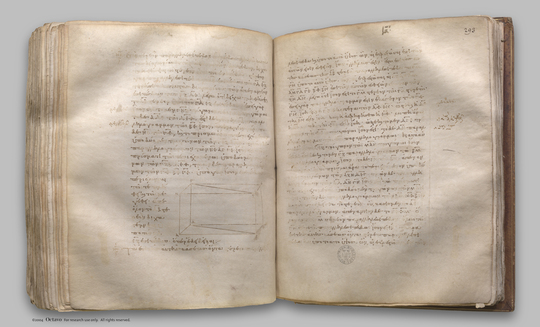index prev next | digilib folio 297

Parallelepipedal solids which are on the same base and of the same height, and in which the extremities of the sides which stand up are on the same straight lines, are equal to one another.
| Τὰ ἐπὶ τῆς αὐτῆς βάσεως ὄντα στερεὰ παραλληλεπίπεδα καὶ ὑπὸ τὸ αὐτὸ ὕψος, ὧν αἱ ἐφεστῶσαι ἐπὶ τῶν αὐτῶν εἰσιν εὐθειῶν, ἴσα ἀλλήλοις ἐστίν. Ἔστω ἐπὶ τῆς αὐτῆς βάσεως τῆς ΑΒ στερεὰ παραλληλεπίπεδα τὰ ΓΜ, ΓΝ ὑπὸ τὸ αὐτὸ ὕψος, ὧν αἱ ἐφεστῶσαι αἱ ΑΗ, ΑΖ, ΛΜ, ΛΝ, ΓΔ, ΓΕ, ΒΘ, ΒΚ ἐπὶ τῶν αὐτῶν εὐθειῶν ἔστωσαν τῶν ΖΝ, ΔΚ: λέγω, ὅτι ἴσον ἐστὶ τὸ ΓΜ στερεὸν τῷ ΓΝ στερεῷ. Ἐπεὶ γὰρ παραλληλόγραμμόν ἐστιν ἑκάτερον τῶν ΓΘ, ΓΚ, ἴση ἐστὶν ἡ ΓΒ ἑκατέρᾳ τῶν ΔΘ, ΕΚ: ὥστε καὶ ἡ ΔΘ τῇ ΕΚ ἐστιν ἴση. κοινὴ ἀφῃρήσθω ἡ ΕΘ: λοιπὴ ἄρα ἡ ΔΕ λοιπῇ τῇ ΘΚ ἐστιν ἴση. ὥστε καὶ τὸ μὲν ΔΓΕ τρίγωνον τῷ ΘΒΚ τριγώνῳ ἴσον ἐστίν, τὸ δὲ ΔΗ παραλληλόγραμμον τῷ ΘΝ παραλληλογράμμῳ. διὰ τὰ αὐτὰ δὴ καὶ τὸ ΑΖΗ τρίγωνον τῷ ΜΛΝ τριγώνῳ ἴσον ἐστίν. ἔστι δὲ καὶ τὸ μὲν ΓΖ παραλληλόγραμμον τῷ ΒΜ παραλληλογράμμῳ ἴσον, τὸ δὲ ΓΗ τῷ ΒΝ: ἀπεναντίον γάρ: καὶ τὸ πρίσμα ἄρα τὸ περιεχόμενον ὑπὸ δύο μὲν τριγώνων τῶν ΑΖΗ, ΔΓΕ, τριῶν δὲ παραλληλογράμμων τῶν ΑΔ, ΔΗ, ΓΗ ἴσον ἐστὶ τῷ πρίσματι τῷ περιεχομένῳ ὑπὸ δύο μὲν τριγώνων τῶν ΜΛΝ, ΘΒΚ, τριῶν δὲ παραλληλογράμμων τῶν ΒΜ, ΘΝ, ΒΝ. κοινὸν προσκείσθω τὸ στερεόν, οὗ βάσις μὲν τὸ ΑΒ παραλληλόγραμμον, ἀπεναντίον δὲ τὸ ΗΕΘΜ: ὅλον ἄρα τὸ ΓΜ στερεὸν παραλληλεπίπεδον ὅλῳ τῷ ΓΝ στερεῷ παραλληλεπιπέδῳ ἴσον ἐστίν. Τὰ ἄρα ἐπὶ τῆς αὐτῆς βάσεως ὄντα στερεὰ παραλληλεπίπεδα καὶ ὑπὸ τὸ αὐτὸ ὕψος, ὧν αἱ ἐφεστῶσαι ἐπὶ τῶν αὐτῶν εἰσιν εὐθειῶν, ἴσα ἀλλήλοις ἐστίν: ὅπερ ἔδει δεῖξαι. | Parallelepipedal solids which are on the same base and of the same height, and in which the extremities of the sides which stand up are on the same straight lines, are equal to one another. Let CM, CN be parallelepipedal solids on the same base AB and of the same height, and let the extremities of their sides which stand up, namely AG, AF, LM, LN, CD, CE, BH, BK, be on the same straight lines FN, DK; I say that the solid CM is equal to the solid CN. For, since each of the figures CH, CK is a parallelogram, CB is equal to each of the straight lines DH, EK, [I. 34] hence DH is also equal to EK. Let EH be subtracted from each; therefore the remainder DE is equal to the remainder HK. Hence the triangle DCE is also equal to the triangle HBK, [I. 8, 4] and the parallelogram DG to the parallelogram HN. [I. 36] For the same reason the triangle AFG is also equal to the triangle MLN. But the parallelogram CF is equal to the parallelogram BM, and CG to BN, for they are opposite; therefore the prism contained by the two triangles AFG, DCE and the three parallelograms AD, DG, CG is equal to the prism contained by the two triangles MLN, HBK and the three parallelograms BM, HN, BN. Let there be added to each the solid of which the parallelogram AB is the base and GEHM its opposite; therefore the whole parallelepipedal solid CM is equal to the whole parallelepipedal solid CN. |